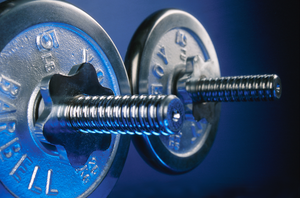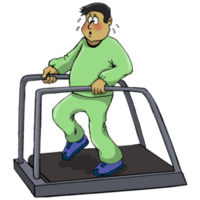Men, Exercise and Broken Bones

One of the problems that we all face as we get older is that unless we are careful, our bones can gradually become weaker. This is a particular problem in women, but a growing body of research indicates that men can run into trouble as well. At one end of the spectrum is “osteopenia:” a reduction in bone mineral density, and at the other end of the spectrum is full-blown osteoporosis.
The reason for taking the problem so seriously is that any degree of thinning of the bones can predispose us to so-called “osteoporotic fractures.” Sad to say, serious fractures are common among older people and can have devastating consequences, particularly if a hip is broken. Man people find it difficult to walk again. For years now we have recommended that women should take exercise to reduce the risk of thinning of their bones, particularly after menopause. But now research published in PLoS Medicine indicates that men who participate in sport or other vigorous activity may also reduce their risk of fractures.
Karl Michaelsson and colleagues at University Hospital, Uppsala, Sweden, report research in which over 2000 men who were initially studied in 1970-1973. The amount of physical activity that they took outside working hours was recorded, and then they were questioned again as they aged. Each of the surviving men was questioned again when they were aged 60, 70, 77, and 82. About half of the men were still alive at the end of the study, and the researchers recorded the number of fractures that the men had suffered during the 35 years of the study.
Based on the answers to the questions on physical activity at the start of the study, the researchers divided the men into three groups: those whose lifestyle was considered to be ”sedentary,” those whose leisure activities included some walking and cycling and those who participated in sports for at least 3 hours a week. These were referred to as the low, medium, and high-activity groups. Over the 35 years, 428 men had at least one fracture and 134 broke a hip. However, there were significant differences between the groups. 20% of the low-activity men had fractures, compared with 13% of those with medium activity and only 8% of those in the high-activity group. Of greatest importance was that the chance of having a hip fracture – the worst type of broken bone in an older person – was dramatically reduced by increased activity.
The researchers conclude that taking exercise reduces the risk of osteoporotic fracture in men. Participating in sports seems to be particularly effective: they calculated that one-third of fractures could be prevented if men could be persuaded to take part in sports regularly.
There is also an excellent summary by Harri Sievänen and Pekka Kannus from Tampere in Finland. As always each entire article is available online.
And I am to get my running shoes this very instant…
Here Comes the Sun: To Screen or Not To Screen?

I have been worried to see some people – all, I think, without scientific training – proclaiming that there is no need to protect ourselves against the sun because there is no evidence that sulight causes any health problems.
Ultraviolet radiation (UVR) from the sun has been part of the environment since the first cells began to form. When we discuss the effects of UVR on human health and the environment, the range of UV wavelengths is often subdivided into:
- UVA (400–315 nm), also called Long Wave or “blacklight”
- UVB (315–280 nm), also called Medium Wave
- UVC (< 280 nm) also called Short Wave or “germicidal”
The key questions are these:
Can sunlight cause health problems?
Do the benefits of sunlight outweigh their risks?”
UVB is required for the conversion of 7-deoxycholesterol to vitamin D, (the sunshine vitamin!) which is critically important in the maintenance of healthy bones, although there may also be another mechanism by which vitamin D is generated in the body. As we have seen research is making clear that vitamin D has other potential roles in the maintenance of human health. Low levels of vitamin D have been linked to:
- Rickets
- Osteomalacia
- Osteoporosis
- Maintaining the integrity of cell membranes
- Type 2 diabetes mellitus
- Schizophrenia
- Multiple sclerosis
- Pre-eclampsia (hypertension and accompanying problems during the late stages of pregnancy)
- Some types of cancer
- Fibromyalgia-like pains
- Immune deficiency: Africa Americans do not generate enough of a protein needed to ward off tuberculosis. Why? Because the protein needs vitamin D to be activated, and dark skin is inefficient at absorbing and converting UVR. It may also be that we see epidemics of colds and flu in the winter because that is when we have low levels of vitamin D, which allows the viruses to overwhelm our immune defenses.
This does not necessarily mean that taking extra vitamin D will ward off all of these problems.
In the days before the Industrial Revolution, unless we lived in the frozen North, we had no trouble in getting the amount of vitamin D that we needed. In most of the United States, during the summer months, 10-15 minutes outdoors at midday will generate around 10,000 international units (IU’s) of vitamin D in an average fair-skinned person. This is far in excess of the government’s dietary recommendations of 200 IU’s/day in people up to age 50, 400 IU’s up to age 70 and 600 IU’s in people over 70. Not surprisingly many experts – me included – believe and have provided evidence that these daily requirements are much too low. (Have a look at the comments here.)
Of course many of us do not spend much time outside and don’t take in as much in the way of vitamin D containing foods – such as milk and salmon – as we should. I’ve seen evidence to suggest that we in Atlanta are probably at the Northernmost point in the United States were we could hope to get enough sunshine and therefore vitamin D from modest winter exposure to the sun.
Recent data has suggested that if you spend no time at all in the sun, then you may need as much as 4,000 IU’s of vitamin D/day, though that figure has not yet been widely accepted.
Exposure to UVR, whether of solar or artificial origin, also carries potential risks to human health. UVR is a known carcinogen and excessive exposure, at least to the solar radiation in sunlight, increases the risk of cancer of the lip, basal cell, and squamous cell carcinoma of the skin and melanoma, particularly in fair-skinned populations. There is also evidence that solar UVR increases risk of several diseases of the eye, including cortical cataract, some conjunctival neoplasms, and perhaps also melanoma of the eye.
We have good data for the existence of a threshold amount of UV-B exposure that may lead to the formation of cataracts. The amount needed to cause cataracts depends in part on the amount of pigment in the eye, so albino rats get cataracts with much lower exposures to UV-B.
So what to do?
Sunlight has a definite benefit in preventing or treating many clinical problems and it is no surprise that after 3000 millennia we are adapted to make use of the sun’s largesse. What is less easy to understand is why an excess of sunlight can cause so many problems, unless it is our hairlessness and environmental change that has lead to a loss of the ozone layer.
Some years ago it was suggested that sunscreens may themselves cause skin cancer, but the data has shown that to be false. Indeed modern sunscreens almost certainly reduce melanoma risk.
So how do we balance the positive and negative effects of sunlight? A recent review precisely reflects my own thinking:
- We need some sunlight
- Depending on where you live, you need only a few minutes each day
- Sunscreens confer protection on the skin without blocking all the health benefits
- If you have a medical reason for avoiding sunlight, then your health care provider should measure your vitamin D status.
Exercise Beats "Dieting" in Managing Obesity

An important report was presented at the Scientific Meeting of the United Kingdom Society for Behavioural Medicine in Cambridge earlier this month.
A team of researchers from Leeds Metropolitan University and the University of Hull studied 62 women aged 24 to 55. They all had a Body Mass Index (BMI) over 30, which is classed as clinically obese. (Regular readers will know that most experts have moved away from using BMI to evaluate metabolic and cardiovascular risks).
The program encouraged women not to diet but to take part in exercise classes. They were required to do four hours a week of exercise, such as t’ai chi, aqua aerobics or circuit classes. So it was not necessary to become a hard core exercise freak!
The researchers found significant improvements in health and mental well-being.
The women in the study were also taught about good eating habits, including how to read food labels and cook food, and they received social support and behavioral therapy to help them respond to body cues such as hunger and feeling full.
After a year, the women had only lost a little weight but were significantly fitter and happier with themselves. Their blood pressure, heart rate and cholesterol fell and respiratory fitness increased. And the women also felt better in terms of general well-being, body image, self-perception and stress.
This small, simple study re-emphasizes what we have said to tens of thousands of people: fad diets will only help in the short term. For all practical purposes you can eat what you want, but in moderation. But try gradually to change the composition of your diet. I have written some advice on doing that. In Healing, Meaning and Purpose we also provide a number of tactics to help you tackle some of the psychological and social hurdles that may stand in the way of weight management. Which include something not often discussed: the twelve ego-fears that can be the hidden drivers to a lot of our behavior.
Understand them and you can gain a remarkable degree of control of your thinking and your emotions.
And it is exercise that should be the centerpiece of a weight management strategy.
This was re-inforced by a study published last week in the Archives of Internal Medicine: people who lost weight by restricting calories lost bone mineral density. Those with exercise-induced weight loss did not.
And as you doubtless know, loss of bone mineral density is one of the key risk factors for osteoporosis.
So please don’t buy in to some new “miracle” diets: they simply don’t exist.
Instead:
- Gradually increase your level of exercise
- Slowly change the composition of your diet
- Keep your internal organs – especially your intestine – in balance
- Develop your food awareness (I am going to do a whole post/article about that!)
- Learn how to deal with the psychological, social subtle and spiritual aspects of suboptimal eating (Check out the reources that I have already provided + a new eBook in the New Year)
And before you know it, you will be exactly where you want to be.
Promise!
Lack of activity destroys the good condition of every human being, while movement and methodical physical exercise save it and preserve it.”
–Plato (Athenian Philosopher, 428-348 B.C.E.)
“The way to cheerfulness is to keep our bodies in exercise and our minds at ease.”
–Sir Richard Steele (English Dramatist and Essayist, 1672-1729)
Colas, Carbonated Drinks and Osteoporosis

There is some new research reported in the October issue of the American Journal of Clinical Nutrition that has not been as widely reported as I had hoped.
According to the results of the Framingham Osteoporosis Study regular consumption of carbonated cola drinks may increase risk for low bone mineral density (BMD) in women.
There are at least four possible reasons for the adverse effect of carbonated drinks on BMD:
- They displace the consumption of healthier drinks
- Most contain caffeine
- Phosphoric acid (H3PO4)
- High fructose corn syrup might also weaken bone
The researchers used a sensitive technique called dual-energy x-ray absorptiometry to measure BMD at the spine and at 3 hip sites in 1413 women and in 1125 men in the Framingham Osteoporosis Study. They also evaluated dietary intake with a food frequency questionnaire. Using a statistical model each BMD measure was regressed on the frequency of soft drink consumption after adjustment for body mass index, height, age, energy intake, physical activity score, smoking, alcohol use, total calcium intake, total vitamin D intake, caffeine from non-cola sources, season of measurement, and, for women, menopausal status and estrogen use.
This study showed that women are more sensitive to the effects of cola than men, but the mechanism remains unclear. If we look at potential explanations for the reduced BMD, the researchers ruled out item one: the possibility that cola replaces healthier beverages, such as milk. Why is low BMD more of a problem in women? They suggest that more physical activity, a diet higher in calcium and different hormone levels might help protect males from the disadvantages of drinking cola. Until further research is done, however, women (and men) can keep their bones strong with regular weight-bearing exercise and high intake of calcium and vitamin D.
Turmeric and Arthritis
I recently reported about some research from SIngapore that indicated that the spice turmeric might help with cognition.
Today there is a study form the University of Arizona in the journal Arthritis and Rheumatism suggesting that the spice may also be helpful in experimental rheumatoid arthritis. In line with most other studies of herbal supplements it is interesting that the maximal effect was obtained by using the natural form of turmeric, that contains three major "curcuminoids," the likely active ingredients. If one of the three is missing, the effect is a lot less.
The extracts appears to work by preventing the activation of a protein that controls when genes are switched on or off in the joint. Once the protein known as NF-KB is activated, it binds to genes and increases the production of inflammatory proteins, which in turn attack the joints.
This is not a surprise: In traditional Indian Ayurvedic medicine turmeric has been used for centuries as a treatment for inflammatory disorders including arthritis. Based on that, dietary supplements containing turmeric rhizome and turmeric extracts have been sold for years. However, there’s been little direct evidence that they are helpful.
We are going to need more research before we can sy whether turmeric supplements can be recommended for medicinal pruposes, and eating more spices is unlikely to work.
These findings are opening up a new approach to treating not just rheumatoid arthritis, but perhaps also other inflammatory diseases such as inflammatory bowel disease, asthma and multiple sclerosis. Interestingly the turmeric extract also has another effect: it deactivates a biochemical pathway that leads to the resorption of bone. So it may help with osteoporosis.
Predicting Osteoporosis
Osteoporosis or thinning of the bones, is an extremely common problem that may lead to bone fractures, particularly in older, postmenopausal women. But sadly we are not good at predicting who will get a fracture. Simply measuring bone density is a long way from being a perfect predictor of who will go on to break bones because of osteoporosis.
A new research study from Melbourne, Australia has just come out in the journal Radiology. The researchers have devised a mathematical formula that is quite good at predicting who will get a fracture over a two-year period. The formula calculate’s a woman’s risk of developing a fracture with 75% accuracy. The fact that it misses 25% may not sound good, but it’s actually a big advance.
The researchers examined 231 women with osteoporosis who had suffered bone fractures and 448 women who had not.They discovered that several factors including bone density levels in the spine and hip, weight, and the number of previous fractures were related to the likelihood of sustaining another fracture. By taking all these measurements into account, the team was able to develop a predictive formula. The formula itself is enough to make your head spin, but it will be very easy to use in practice.
We do have a number of effective treatments, including hormone replacement therapy, vitamin D and calcium supplements, and non-hormonal medicines including the bisphosphonates like sodium alendronate (Fosamax®) 10 mg a day or 70 mg once a week, risedronate (Actonel®) 5mg a day or 35mg once a week or and ibandronate (Boniva® once a month)and parathyroid hormone. There are several other medicines in the pipeline, and there have been claims that homeopathy may also help.
The trouble has been knowing which patients to target. Nobody wants to give everyone medicines if we can avoid it. Hence any form of accurate prediction about who might benefit from what, is to be welcomed.
Remember that there is good evidence that several small lifestyle adjustments can reduce your risk of osteoporosis:
- Exercise
- A diet rich in calcium, omega-3 fatty acids and green vegetables. Reduce sodium and refined sugar.
- Supplemental calcium with vitamin D, magnesium and boron
- Do not smoke
- Avoid excessive amounts of alcohol
There are seveal medicines and illnesses that can increase the risk of osteoporosis, and a health care provider will know to be particularly careful about monitoring bone mineral density and applying this new formula.






